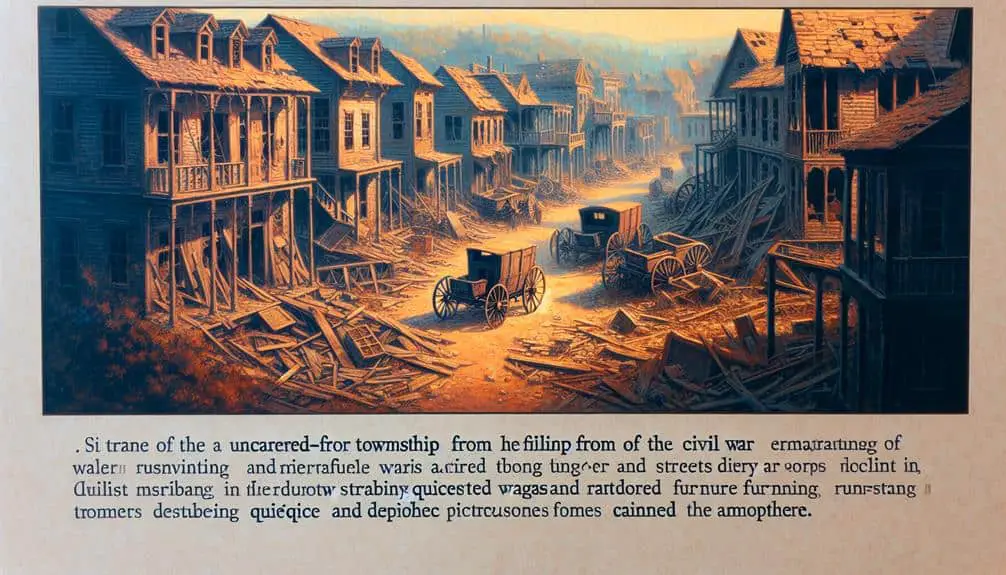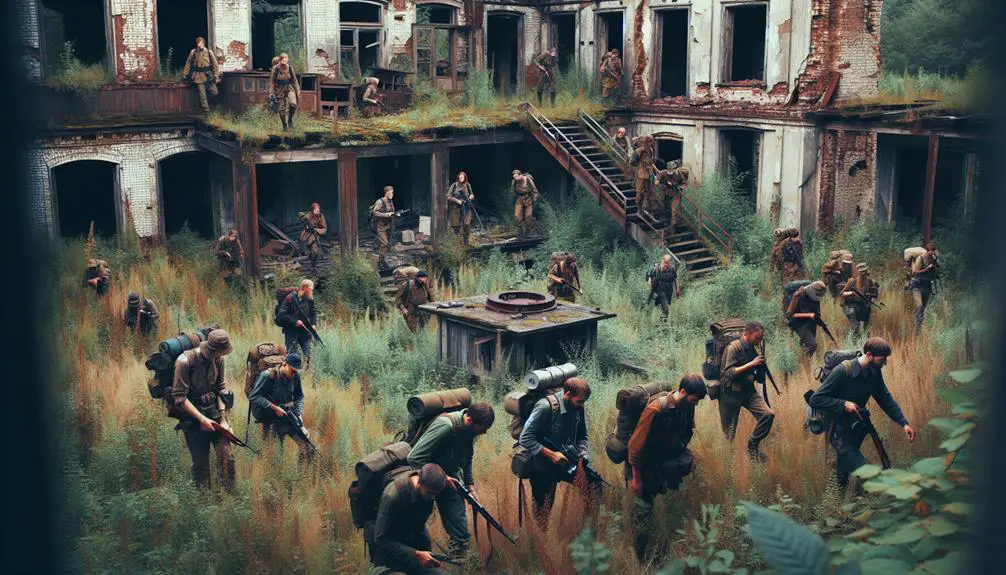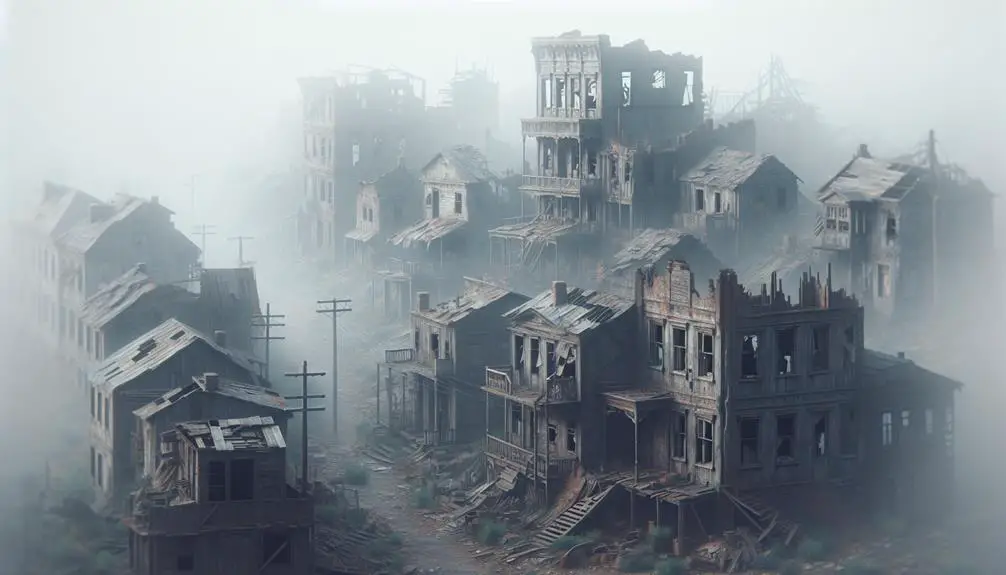Civil War ghost town residents faced economic decline, disasters, and societal changes. After desertion, they struggled with reintegration and fading memories. Haunting legends and supernatural myths emerged, adding to the eerie atmosphere. Today, archaeology reveals relics and community efforts preserve these remnants. The stories of these ghost town residents are a chilling reminder of the lasting impact of the war. Explore further to uncover the full tale of these abandoned communities.
Key Points
- Economic decline and disasters forced residents to leave their homes.
- Former residents faced reintegration challenges in starting anew.
- Memories of old homes faded into forgotten corners over time.
- Struggles of moving forward were haunted by echoes of the past.
- Alienation and disillusionment contributed to the decline of these ghost towns.
Historical Context of Civil War Ghost Towns
During the Civil War era, many towns across the United States that are now considered ghost towns played significant roles in the historical events of that time. The Reconstruction era following the Civil War was a tumultuous period, marked by efforts to rebuild the nation and address the societal changes brought about by the abolition of slavery. In these ghost towns, the presence of Confederate sympathizers added another layer of complexity to the already strained social fabric.
As the nation grappled with the aftermath of the war, these towns became sites of contention and struggle. Confederate sympathizers, who'd supported the South during the conflict, often found themselves marginalized in the changing political landscape. This sense of alienation and disillusionment contributed to the gradual decline of these once-thriving communities, eventually leading to their abandonment.
Understanding the historical context of Civil War ghost towns sheds light on the complex dynamics that shaped their fate. The legacy of these towns serves as a reminder of the enduring impact of the Civil War and its aftermath on American society.
Reasons for Abandonment
Multiple factors contributed to the abandonment of Civil War ghost towns, each playing a significant role in the decline of these once vibrant communities. Economic decline was a primary reason for the desertion of these towns. As the industries that once sustained them dwindled or moved elsewhere, residents were forced to seek opportunities in other areas, leaving behind their homes and businesses. The lack of economic prospects made staying unsustainable for many.
Natural disasters also played a part in the abandonment of Civil War ghost towns. Floods, fires, and other catastrophic events could devastate these communities, destroying infrastructure and making it difficult for residents to rebuild. The constant threat of natural disasters could create an atmosphere of uncertainty and fear, prompting people to relocate to safer regions.
In combination, economic decline and natural disasters created a situation where the residents of Civil War ghost towns had no choice but to leave. These factors, among others, ultimately led to the abandonment of these once-thriving communities.
Life After Desertion
After the abandonment of Civil War ghost towns, the remaining structures stood as silent witnesses to the once bustling life that had filled the streets. The residents who left these towns faced a myriad of reintegration challenges as they sought to rebuild their lives elsewhere. The memories of their old homes slowly faded into forgotten corners of their minds, replaced by the struggles of starting anew.
For many, the shift wasn't easy. They had to find new sources of livelihood, forge new social connections, and adapt to different environments. The echoes of the past lingered, haunting their attempts to move forward. Some struggled with feelings of displacement and a sense of loss for the communities they once called home. The abandoned towns became symbols of both the resilience and fragility of human existence.
Despite the challenges, these former residents persevered, creating new lives and forging ahead. The ghost towns they left behind became relics of the past, holding forgotten memories that whispered tales of a bygone era.
Haunting Legends and Myths
As the shadows lengthened over the abandoned streets, whispers of haunting legends and myths began to weave themselves into the fabric of the Civil War ghost towns. These tales, passed down through generations, tell of ghost stories and supernatural encounters that linger in the remnants of these once-thriving communities.
One prevalent legend revolves around the spectral figure of a soldier, condemned to roam the streets eternally searching for something lost in battle. Locals claim to have heard his ghostly footsteps echoing through the deserted buildings, a haunting reminder of the town's turbulent past.
Another eerie myth speaks of a cursed well, said to be a portal to the underworld. According to the legend, those who gaze into its depths are met with visions of the fallen soldiers, their anguished faces forever trapped within the water's reflection.
These haunting tales serve as a reminder of the enduring impact of war on a community, leaving behind not only physical ruins but also a legacy of ghostly lore that continues to intrigue visitors and locals alike.
Modern-Day Discoveries and Preservation
Numerous archaeological expeditions have unearthed valuable artifacts and insights, shedding light on the historical significance of Civil War ghost towns and prompting efforts for their preservation. These discoveries have captivated historians and enthusiasts alike, offering a glimpse into the past and the lives of those who once inhabited these abandoned settlements.
- Archaeological Findings: Excavations have revealed Civil War-era relics such as bullets, uniforms, and personal belongings, providing tangible connections to the past.
- Structural Remnants: Ruins of buildings and infrastructure offer clues about the town layout and daily life during the Civil War era.
- Documentation and Mapping: Through detailed documentation and mapping of sites, researchers can create thorough records for future study and preservation efforts.
- Community Engagement: Collaborative initiatives involving local communities help raise awareness and garner support for preserving these historically significant sites.
- Conservation Strategies: Conservationists are employing innovative techniques to protect fragile artifacts and structures, ensuring their longevity for future generations.
Frequently Asked Questions
What Were the Specific Challenges Faced by Civil War Ghost Town Residents in Terms of Daily Survival and Living Conditions?
Facing challenges in daily survival, Civil War ghost town residents coped with scarce resources and harsh living conditions. You had to rely on ingenuity and resilience to endure the hardships of life in a desolate environment.
How Did the Presence of Soldiers and Military Activity Impact the Daily Lives of Residents in Civil War Ghost Towns?
The military presence heavily impacted residents in Civil War ghost towns. Soldiers disrupted daily life, causing fear and instability. Their activities led to shortages, destruction, and forced evacuations, leaving inhabitants struggling to survive in an environment marred by conflict.
Were There Any Known Instances of Paranormal Activity or Supernatural Occurrences Reported by Civil War Ghost Town Residents?
Imagine encountering ghostly apparitions wandering the abandoned streets. Residents of Civil War ghost towns reported chilling paranormal encounters and eerie supernatural sightings. The stories spun around the town would make your hair stand on end.
How Did the Abandonment of Civil War Ghost Towns Impact the Surrounding Communities and Neighboring Towns?
The abandonment of Civil War ghost towns had a significant impact on the surrounding communities and neighboring towns. It disrupted the economy, leading to job losses, decreased property values, and hindered social integration by dispersing residents.
Are There Any Records or Accounts of Former Civil War Ghost Town Residents Attempting to Return to Their Abandoned Homes After the War Ended?
Historical records show that former Civil War ghost town residents faced significant reintegration challenges. Return attempts were met with adaptation difficulties as abandoned homes often stood in disrepair or new occupants had settled in, hindering their efforts.



